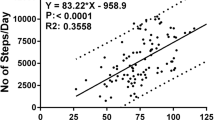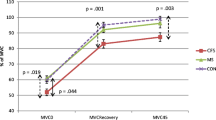Abstract
To assess electromyographic parameters of neuromuscular fatigue in knee extensors and their association with clinical, functional and emotional features in patients with rheumatoid arthritis (RA). Thirty-eight female patients with RA participated. Electromyography parameters (changes in signal amplitude, represented by the root mean square, and frequency content, represented by median frequency—MDF) were assessed during a submaximal (60%) isometric contraction of the knee extensors, sustained for 60 s. Clinical characteristics; the 28-joint Disease Activity Score (DAS-28) in which includes count of swollen joints (out of the 28) and tender joints (out of the 28), the erythrocyte sedimentation rate and global disease activity measured on a visual analogue scale; serum C reactive protein (CRP); information on treatment; the Health Assessment Questionnaire; the Functional Assessment of Chronic Illness Therapy fatigue scale (FACIT-F); the Short Form Health Survey (SF-36) and the International Physical Activity Questionnaire (IPAQ), were also assessed. The mean patient age was 51.0 ± 8.2 years, mean disease activity score was 11.5 ± 7.1, and mean CRP level was 8.0 ± 7.8 mg/dL. There was a moderate correlation between MDF and age (r = 0.5), as well as weak correlations of MDF with FACIT-F (r = 0.3), physical functioning (r = − 0.3) and vitality domains (r = − 0.3) of the SF-36, and IPAQ (r = − 0.3) (p ≤ 0.05 for all). No association was observed between electromyography measurements and clinical or treatment features. The electromyographic parameter MDF was correlated with perception of fatigue, age, physical functioning and vitality domains of SF-36, and physical activity level in this sample. These results indicate that primary muscle factors should also be considered when managing perceived fatigue in patients with RA.



Similar content being viewed by others
References
Lee DM, Weinblatt ME (2001) Rheumatoid arthritis. Lancet 358:903–911
Mota LMH, Cruz BA, Brenol CV, Pereira IA, Rezende-Fronza LS, Bertolo MB et al (2012) Consenso 2012 da Sociedade Brasileira de Reumatologia para o tratamento da artrite reumatoide. Rev Bras Reumatol 52(2):135–174
Cramp F, Hewlett S, Almeida C, Kirwan JR, Choy EH, Chalder T et al (2013) Non-pharmacological interventions for fatigue in rheumatoid arthritis. Cochrane Database Syst Rev. https://doi.org/10.1002/14651858.CD008322.pub2
Wolfe F, Hawley DJ, Wilson K (1996) The prevalence and meaning of fatigue in rheumatic disease. J Rheumatol 23(8):1407–1417
Pollard LC, Choy EH, Gonzalez J, Khoshaba B, Scott DL (2006) Fatigue in rheumatoid arthritis reflects pain, not disease activity. Rheumatology 45(7):885–889
Novaes GS, Perez MO, Beraldo MBB, Pinto CRC, Gianini RJ (2011) Correlação de fadiga com dor e incapacidade na artrite reumatoide e na osteoartrite, respectivamente. Rev Bras Reumatol 51(5):451–455
Staud R (2012) Peripheral and central mechanisms of fatigue in inflammatory and non-inflammatory rheumatic diseases. Curr Rheumatol Rep. https://doi.org/10.1007/s11926-012-0277-z
Hewlett S, Chalder T, Choy E, Cramp F, Davis B, Dures E et al (2011) Fatigue in rheumatoid arthritis: time for a conceptual model. Rheumatology. https://doi.org/10.1093/rheumatology/keq282
Nikolaus S, Bode C, Taal E, van de Laar MA (2013) Fatigue and factors related to fatigue in rheumatoid arthritis: a systematic review. Arthritis Care Res (Hoboken). https://doi.org/10.1002/acr.21949
Boyas S, Gue´vel A (2011) Neuromuscular fatigue in healthy muscle: underlying factors and adaptation mechanisms. Ann Phys Rehabil Med. https://doi.org/10.1016/j.rehab.2011.01.001
Al-Mulla MR, Sepulveda F, Colley M (2011) A review of non-invasive techniques to detect and predict localised muscle fatigue. Sensors (Basel). https://doi.org/10.3390/s11040354
Hewlett S, Choy E, Kirwan J (2012) Furthering our understanding of fatigue in rheumatoid arthritis. J Rheumatol. https://doi.org/10.3899/jrheum.120724
Rondelli RR, Dal Corso S, Simões A, Malaguti C (2009) Methods for the assessment of peripheral muscle fatigue and its energy and metabolic determinants in COPD. J Bras Pneumol 35(11):1125–1135
Basmajian JV, de Luca CJ (1985) Muscles alive: their functions revealed by electromyography, 5th edn. Williams and Wilkins, Baltimore
Merletti R, Roy S (1996) Myoelectric and mechanical manifestations of muscle fatigue in voluntary contractions. J Orthop Sports Phys Ther 6:342–353
Dartnall TJ, Nordstrom MA, Semmler JG (2008) Motor unit synchronization is increased in biceps brachii after exercise induced damage to elbow flexor muscles. J Neurophysiol. https://doi.org/10.1152/jn.00686.2007
Arjunan SP, Kumar DK, Naik G (2014) Computation and evaluation of features of surface electromyogram to identify the force of muscle contraction and muscle fatigue. Biomed Res Int. https://doi.org/10.1155/2014/197960
Tarata MT (2003) Mechanomyography versus Electromyography, in monitoring the muscular fatigue. Biomed Eng Online 11:2:3
Kallenberg LAC, Schulte E, Disselhorst-Klug C, Hermens HJ (2007) Myoelectric manifestations of fatigue at low contraction levels in subjects with and without chronic pain. J Electromyogr Kinesiol 17(3):264–274
Baker JF, Von Feldt J, Mostoufi-Moab S, Noaiseh G, Taratuta E, Kim W et al (2014) Deficits in muscle mass, muscle density, and modified associations with fat in rheumatoid arthritis. Arthritis Care Res (Hoboken). https://doi.org/10.1002/acr.22328
Häkkinen A, Sokka T, Kautiainen H, Kotaniemi A, Hannonen P (2004) Sustained maintenance of exercise induced muscle strength gains and normal bone mineral density in patients with early rheumatoid arthritis: a 5 year follow up. Ann Rheum Dis. https://doi.org/10.1136/ard.2003.013003
Arnett FC, Edworthy SM, Bloch DA, McShane DJ, Fries JF, Cooper NS et al (1988) The American Rheumatism Association 1987 revised criteria for the classification of rheumatoid arthritis. Arthritis Rheum 31:315–324
Strand V, Rentz AM, Cifaldi MA, Chen N, Roy S, Revicki D (2012) Health-related quality of life outcomes of adalimumab for patients with early rheumatoid arthritis: results from a randomized multicenter study. J Rheumatol. https://doi.org/10.3899/jrheum.10116
Samuel D, Rowe P, Nicol A (2013) The functional demand (FD) placed on the knee and hip of older adults during everyday activities. Arch Gerontol Geriatr. https://doi.org/10.1016/j.archger.2013.03.003
Hermens HJ, Freriks B, Disselhorst-Klug C, Rau G (2000) Development of recommendations for SEMG sensors and sensor placement procedures. J Electromyogr Kinesiol 10:361–374
Beck TW, Housh TJ, Cramer JT, Weir JP (2009) The effects of interelectrode distance over the innervation zone and normalization on the electromyographic amplitude and mean power frequency versus concentric, eccentric, and isometric torque relationships for the vastus lateralis muscle. J Electromyogr Kinesiol 19:219–231
Cella D, Yount S, Sorensen M, Chartash E, Sengupta N, Grober J (2005) Validation of the Functional Assessment of Chronic Illness Therapy Fatigue Scale relative to other instrumentation in patients with rheumatoid arthritis. J Rheumatol 32:811–819
Bruce B, Fries JF (2005) The Health Assessment Questionnaire (HAQ). Clin Exp Rheumatol 23(5 Suppl 39):S14–S18
Matcham F, Scott IC, Rayner L, Hotopf M, Kingsley GH, Norton S, Scott DL et al (2014) The impact of rheumatoid arthritis on quality-of-life assessed using the SF-36: a systematic review and meta-analysis. Semin Arthritis Rheum. https://doi.org/10.1016/j.semarthrit.2014.05.001
Matsudo S, Timóteo A, Matsudo V, Andrade D, Andrade E, Oliveira LC et al (2001) International physical activity questionnaire (IPAQ): study of validity and reliability in Brazil. Rev bras ativ fís saúde 6:05–18
Weinstein AA, Drinkard BM, Diao G, Furst G, Dale JK, Straus SE et al (2009) Exploratory analysis of the relationships between aerobic capacity and self-reported fatigue in patients with rheumatoid arthritis, polymyositis, and chronic fatigue syndrome. PMR. https://doi.org/10.1016/j.pmrj.2009.04.007
Dancy CP, Reidy J (2004) Statistics without maths for psychology. Pearson, Harlow
Balsamo S, Diniz LR, dos Santos-Neto LL, da Mota LM. Balsamo S, Diniz LR, dos Santos-Neto LL, da Mota LM (2014) Exercise and fatigue in rheumatoid arthritis. Isr Med Assoc J 16(1):57–60
Gandevia SC (2001) Spinal and supraspinal factors in human muscle fatigue. Physiol Rev 81:1725–1789
Allen DG, Lamb GD, Westerblad H (2008) Skeletal muscle fatigue: cellular mechanisms. Physiol Rev. https://doi.org/10.1152/physrev.00015.2007
Brody LR, Pollock MT, Roy SH, De Luca CJ, Celli B (1991) pH-induced effects on median frequency and conduction velocity of the myoelectric signal. J Appl Physiol 71(5):1878–1885
Ørtenblad N, Sjøgaard G, Madsen K (2000) Impaired sarcoplasmatic reticulum Ca2+ release rate after fatiguing stimulation in rat skeletal muscle. J Appl Physiol 89:210–217
Williams J, Klug G (1995) Calcium exchange hypothesis of skeletal muscle fatigue: a brief review. Muscle Nerve 18:421–434
Cifrek M, Medved V, Tonković S, Ostojić S (2009) Surface EMG based muscle fatigue evaluation in biomechanics. Clin Biomech (Bristol, Avon). https://doi.org/10.1016/j.clinbiomech.2009.01.010
Kapoor S, Fitzpatrick M, Clay E, Bayley R, Wallace GR, Young SP (2012) Metabolomics in the analysis of inflammatory diseases, chapter 11. In: Roessner U (ed) Metabolomics [Internet]. InTech, Rijeka
Lenman JAR, Potter JL (1966) Electromyographic measurement of fatigue in rheumatoid arthritis and neuromuscular disease. Ann Rheum Dis 25:76–84
Belizário JE, Fontes-Oliveira CC, Borges JP, Kashiabara JA, Vannier E (2016) Skeletal muscle wasting and renewal: a pivotal role of myokine IL-6. Springerplus. https://doi.org/10.1186/s40064-016-2197-2
Filippin LI, Teixeira VN, Viacava PR, Lora PS, Xavier LL, Xavier RM (2013) Temporal development of muscle atrophy in murine model of arthritis is related to disease severity. J Cachexia Sarcopenia Muscle. https://doi.org/10.1007/s13539-013-0102-1
Rongen-van Dartel SA, Repping-Wuts H, van Hoogmoed D, Knoop H, Bleijenberg G, van Riel PL, Fransen J (2014) Relationship between objectively assessed physical activity and fatigue in patients with rheumatoid arthritis: inverse correlation of activity and fatigue. Arthritis Care Res (Hoboken). https://doi.org/10.1002/acr.22251
Watanabe K, Holobar A, Kouzaki M, Ogawa M, Akima H, Moritani T (2016) Age-related changes in motor unit firing pattern of vastus lateralis muscle during low-moderate contraction. Age (Dordr). https://doi.org/10.1007/s11357-016-9915-0
Miljkovic N, Lim JY, Miljkovic I, Frontera WR (2015) Aging of skeletal muscle fibers. Ann Rehabil Med. https://doi.org/10.5535/arm.2015.39.2.155
Singh H, Arya S, Talapatra P, Lather K, Mathur R, Singhania A, Chaudhary V (2014) Assessment of fatigue in rheumatoid arthritis (by Functional Assessment of Chronic Illness Therapy-Fatigue score) and its relation to disease activity and anemia. J Clin Rheumatol. https://doi.org/10.1097/RHU.0000000000000073
Escobar ME, Gerhardt C, Roesler E, Kuroda MP, Silva MB, Skare TL (2010) Anemia versus disease activity as cause of fatigue in rheumatoid arthritis. Acta Reumatol Port 35(1):24–28
Bianchi WA, Elias FR, Pinheiro Gda R, Gayer CR, Carneiro C, Grynzpan R et al (2014) Analysis of the association of fatigue with clinical and psychological variables in a series of 371 Brazilian patients with rheumatoid arthritis. Rev Bras Reumatol 54(3):200–207
Campbell RC, Batley M, Hammond A, Ibrahim F, Kingsley G, Scott DL (2012) The impact of disease activity, pain, disability and treatments on fatigue in established rheumatoid arthritis. Clin Rheumatol. https://doi.org/10.1007/s10067-011-1887-y
Acknowledgements
We wish to thank the Exercise Physiology and Pulmonary Function Laboratory at Hospital de Clínicas de Porto Alegre for providing the space for this study. In Addition, we wish to thank the sources of support: Coordenação de Aperfeiçoamento de Pessoal de Nível Superior (CAPES), Conselho Nacional de Desenvolvimento Científico e Tecnológico (CNPq) and Fundo de Incentivo à Pesquisa e Eventos (FIPE).
Author information
Authors and Affiliations
Contributions
RCES and MGP were responsible for data collection and writing this article. VO was responsible for data collection. EGT was responsible for statistical analysis. RRB, RC, RMX and CVB are PHD and responsible for scientific support.
Corresponding author
Ethics declarations
Conflict of interest
The authors declare that they have no competing interests.
Rights and permissions
About this article
Cite this article
do Espírito Santo, R.C., Pompermayer, M.G., Bini, R.R. et al. Neuromuscular fatigue is weakly associated with perception of fatigue and function in patients with rheumatoid arthritis. Rheumatol Int 38, 415–423 (2018). https://doi.org/10.1007/s00296-017-3894-z
Received:
Accepted:
Published:
Issue Date:
DOI: https://doi.org/10.1007/s00296-017-3894-z




